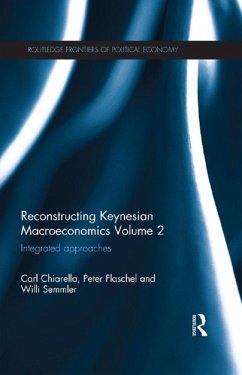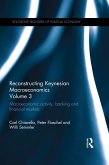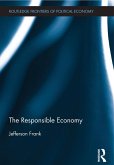Carl Chiarella, Peter Flaschel, Willi Semmler
Reconstructing Keynesian Macroeconomics Volume 2 (eBook, PDF)
Integrated Approaches
46,95 €
46,95 €
inkl. MwSt.
Sofort per Download lieferbar

23 °P sammeln
46,95 €
Als Download kaufen

46,95 €
inkl. MwSt.
Sofort per Download lieferbar

23 °P sammeln
Jetzt verschenken
Alle Infos zum eBook verschenken
46,95 €
inkl. MwSt.
Sofort per Download lieferbar
Alle Infos zum eBook verschenken

23 °P sammeln
Carl Chiarella, Peter Flaschel, Willi Semmler
Reconstructing Keynesian Macroeconomics Volume 2 (eBook, PDF)
Integrated Approaches
- Format: PDF
- Merkliste
- Auf die Merkliste
- Bewerten Bewerten
- Teilen
- Produkt teilen
- Produkterinnerung
- Produkterinnerung

Bitte loggen Sie sich zunächst in Ihr Kundenkonto ein oder registrieren Sie sich bei
bücher.de, um das eBook-Abo tolino select nutzen zu können.
Hier können Sie sich einloggen
Hier können Sie sich einloggen
Sie sind bereits eingeloggt. Klicken Sie auf 2. tolino select Abo, um fortzufahren.

Bitte loggen Sie sich zunächst in Ihr Kundenkonto ein oder registrieren Sie sich bei bücher.de, um das eBook-Abo tolino select nutzen zu können.
This book represents the second of three volumes offering a complete reinterpretation and restructuring of Keynesian macroeconomics and offers a detailed analysis and comparison of two competing types of approaches to Keynesian macroeconomics.
- Geräte: PC
- mit Kopierschutz
- eBook Hilfe
- Größe: 8.46MB
Andere Kunden interessierten sich auch für
![Reconstructing Keynesian Macroeconomics Volume 3 (eBook, PDF) Reconstructing Keynesian Macroeconomics Volume 3 (eBook, PDF)]() Carl ChiarellaReconstructing Keynesian Macroeconomics Volume 3 (eBook, PDF)44,95 €
Carl ChiarellaReconstructing Keynesian Macroeconomics Volume 3 (eBook, PDF)44,95 €![Reconstructing Keynesian Macroeconomics Volume 1 (eBook, PDF) Reconstructing Keynesian Macroeconomics Volume 1 (eBook, PDF)]() Carl ChiarellaReconstructing Keynesian Macroeconomics Volume 1 (eBook, PDF)52,95 €
Carl ChiarellaReconstructing Keynesian Macroeconomics Volume 1 (eBook, PDF)52,95 €![The Keynesian Multiplier (eBook, PDF) The Keynesian Multiplier (eBook, PDF)]() The Keynesian Multiplier (eBook, PDF)46,95 €
The Keynesian Multiplier (eBook, PDF)46,95 €![Post-Keynesian Macroeconomics (eBook, PDF) Post-Keynesian Macroeconomics (eBook, PDF)]() Post-Keynesian Macroeconomics (eBook, PDF)46,95 €
Post-Keynesian Macroeconomics (eBook, PDF)46,95 €![The Economics of Alfred Marshall (Routledge Revivals) (eBook, PDF) The Economics of Alfred Marshall (Routledge Revivals) (eBook, PDF)]() David ReismanThe Economics of Alfred Marshall (Routledge Revivals) (eBook, PDF)40,95 €
David ReismanThe Economics of Alfred Marshall (Routledge Revivals) (eBook, PDF)40,95 €![The Responsible Economy (eBook, PDF) The Responsible Economy (eBook, PDF)]() Jefferson FrankThe Responsible Economy (eBook, PDF)34,95 €
Jefferson FrankThe Responsible Economy (eBook, PDF)34,95 €![Applied Economics and the Critical Realist Critique (eBook, PDF) Applied Economics and the Critical Realist Critique (eBook, PDF)]() Applied Economics and the Critical Realist Critique (eBook, PDF)30,95 €
Applied Economics and the Critical Realist Critique (eBook, PDF)30,95 €-
-
-
This book represents the second of three volumes offering a complete reinterpretation and restructuring of Keynesian macroeconomics and offers a detailed analysis and comparison of two competing types of approaches to Keynesian macroeconomics.
Dieser Download kann aus rechtlichen Gründen nur mit Rechnungsadresse in A, B, BG, CY, CZ, D, DK, EW, E, FIN, F, GR, HR, H, IRL, I, LT, L, LR, M, NL, PL, P, R, S, SLO, SK ausgeliefert werden.
Produktdetails
- Produktdetails
- Verlag: Taylor & Francis eBooks
- Seitenzahl: 512
- Erscheinungstermin: 17. Januar 2013
- Englisch
- ISBN-13: 9781136195815
- Artikelnr.: 47893770
- Verlag: Taylor & Francis eBooks
- Seitenzahl: 512
- Erscheinungstermin: 17. Januar 2013
- Englisch
- ISBN-13: 9781136195815
- Artikelnr.: 47893770
- Herstellerkennzeichnung Die Herstellerinformationen sind derzeit nicht verfügbar.
Carl Chiarella is Professor of Quantitative Finance at the University of Technology, Sydney, Australia.
Peter Flaschel is Professor of Economics at Bielefeld University, Germany.
Willi Semmler is Professor of Economics at The New School for Social Research, New York, USA.
Peter Flaschel is Professor of Economics at Bielefeld University, Germany.
Willi Semmler is Professor of Economics at The New School for Social Research, New York, USA.
Part I: Competing approaches to Keynesian macroeconomics 1. Representative
households or principal-agent capitalism? 2. The two-class Pasinetti model
from a neoclassical perspective 3. Expectations and the (un)importance of
the real wage feedback channel Part II: Supply dynamics, demand-driven
inflation and the distributive cycle 4. Viability and corridor stability in
Keynesian supply driven growth 5. Wicksellian inflation pressure in
Keynesian models of monetary growth 6. Interacting two-country business
fluctuations Part III: The semistructural aggregate demand-aggregate supply
model: theory and evidence 7. Distributive cycles, business fluctuations
and the wage-led/profit-led debate 8. DAD-DAS: estimated convergence and
the emergence of "complex dynamics" 9. International linkages in a
Keynesian two-country model Part IV: The structural Keynes-Metzler-Goodwin
model 10. Integrating macromodels of employment, price and inventory
dynamics 11. Calibration of an unobservable inflation climate 12. A
macroeconometric framework for the analysis of monetary policy Part V:
Extensions 13. The dynamics of "natural" rates of growth and employment 14.
High-order disequilibrium growth dynamics 15. AD-AS disequilibrium dynamics
and endogenous growth Part VI: The road ahead: financial markets 16.
Stabilizing an unstable economy and the choice of policy measures
households or principal-agent capitalism? 2. The two-class Pasinetti model
from a neoclassical perspective 3. Expectations and the (un)importance of
the real wage feedback channel Part II: Supply dynamics, demand-driven
inflation and the distributive cycle 4. Viability and corridor stability in
Keynesian supply driven growth 5. Wicksellian inflation pressure in
Keynesian models of monetary growth 6. Interacting two-country business
fluctuations Part III: The semistructural aggregate demand-aggregate supply
model: theory and evidence 7. Distributive cycles, business fluctuations
and the wage-led/profit-led debate 8. DAD-DAS: estimated convergence and
the emergence of "complex dynamics" 9. International linkages in a
Keynesian two-country model Part IV: The structural Keynes-Metzler-Goodwin
model 10. Integrating macromodels of employment, price and inventory
dynamics 11. Calibration of an unobservable inflation climate 12. A
macroeconometric framework for the analysis of monetary policy Part V:
Extensions 13. The dynamics of "natural" rates of growth and employment 14.
High-order disequilibrium growth dynamics 15. AD-AS disequilibrium dynamics
and endogenous growth Part VI: The road ahead: financial markets 16.
Stabilizing an unstable economy and the choice of policy measures
Part I: Competing approaches to Keynesian macroeconomics 1. Representative
households or principal-agent capitalism? 2. The two-class Pasinetti model
from a neoclassical perspective 3. Expectations and the (un)importance of
the real wage feedback channel Part II: Supply dynamics, demand-driven
inflation and the distributive cycle 4. Viability and corridor stability in
Keynesian supply driven growth 5. Wicksellian inflation pressure in
Keynesian models of monetary growth 6. Interacting two-country business
fluctuations Part III: The semistructural aggregate demand-aggregate supply
model: theory and evidence 7. Distributive cycles, business fluctuations
and the wage-led/profit-led debate 8. DAD-DAS: estimated convergence and
the emergence of "complex dynamics" 9. International linkages in a
Keynesian two-country model Part IV: The structural Keynes-Metzler-Goodwin
model 10. Integrating macromodels of employment, price and inventory
dynamics 11. Calibration of an unobservable inflation climate 12. A
macroeconometric framework for the analysis of monetary policy Part V:
Extensions 13. The dynamics of "natural" rates of growth and employment 14.
High-order disequilibrium growth dynamics 15. AD-AS disequilibrium dynamics
and endogenous growth Part VI: The road ahead: financial markets 16.
Stabilizing an unstable economy and the choice of policy measures
households or principal-agent capitalism? 2. The two-class Pasinetti model
from a neoclassical perspective 3. Expectations and the (un)importance of
the real wage feedback channel Part II: Supply dynamics, demand-driven
inflation and the distributive cycle 4. Viability and corridor stability in
Keynesian supply driven growth 5. Wicksellian inflation pressure in
Keynesian models of monetary growth 6. Interacting two-country business
fluctuations Part III: The semistructural aggregate demand-aggregate supply
model: theory and evidence 7. Distributive cycles, business fluctuations
and the wage-led/profit-led debate 8. DAD-DAS: estimated convergence and
the emergence of "complex dynamics" 9. International linkages in a
Keynesian two-country model Part IV: The structural Keynes-Metzler-Goodwin
model 10. Integrating macromodels of employment, price and inventory
dynamics 11. Calibration of an unobservable inflation climate 12. A
macroeconometric framework for the analysis of monetary policy Part V:
Extensions 13. The dynamics of "natural" rates of growth and employment 14.
High-order disequilibrium growth dynamics 15. AD-AS disequilibrium dynamics
and endogenous growth Part VI: The road ahead: financial markets 16.
Stabilizing an unstable economy and the choice of policy measures







